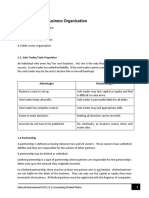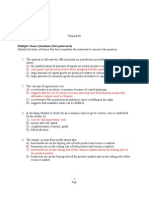CE 10 4th Quarter Exam Reviewer
CE 10 4th Quarter Exam Reviewer
Uploaded by
Alice KrodeCopyright:
Available Formats
CE 10 4th Quarter Exam Reviewer
CE 10 4th Quarter Exam Reviewer
Uploaded by
Alice KrodeOriginal Title
Copyright
Available Formats
Share this document
Did you find this document useful?
Is this content inappropriate?
Copyright:
Available Formats
CE 10 4th Quarter Exam Reviewer
CE 10 4th Quarter Exam Reviewer
Uploaded by
Alice KrodeCopyright:
Available Formats
C. E.
10
4th Quarter Exam
Reviewer
Types of Parables
1) True Parables – Stories based on true, visible scenes and events. For example, seeds growing,
yeast at work, losing a coin... “Self evident truths”.
2) Story Parables – Do not rely on obvious “truths” but instead are based upon “experiences”. For
example, the Parable of the tares, the rich man and Lazarus, etc.
3) Illustrations – Exhibit behaviors to be copied or avoided. For example, the Rich Fool, the Good
Samaritan.
4) Parabolic Sayings – Short statements, such as; Jesus teachings on Salt and Light, “Physician
heal thyself”, “No one sews a new patch on an old garment”, “No one puts new wine in an old
wineskin”, “A pupil is not above his teacher” and “Can a blind man lead a blind man?” Many of these
can be found in Luke chapters 4-7
Lost Sheep
LUKE 15: 1-7
Now the tax collectors and sinners were all gathering around to hear Jesus. But the Pharisees and
the teachers of the law muttered, “This man welcomes sinners and eats with them.” Then Jesus told
them this parable: “Suppose one of you has a hundred sheep and loses one of them. Doesn’t he
leave the ninety-nine in the open country and go after the lost sheep until he finds it? And when he
finds it, he joyfully puts it on his shoulders 6 and goes home. Then he calls his friends and neighbors
together and says, ‘Rejoice with me; I have found my lost sheep.’ I tell you that in the same way there
will be more rejoicing in heaven over one sinner who repents than over ninety-nine righteous persons
who do not need to repent.
Parable of a Rich Fool (Luke 12:13-21)
13 Someone in the crowd said to him, “Teacher, tell my brother to divide the inheritance with me.” 14
Jesus replied, “Man, who appointed me a judge or an arbiter between you?” 15 Then he said to them,
“Watch out! Be on your guard against all kinds of greed; life does not consist in an abundance of
possessions.” 16 And he told them this parable: “The ground of a certain rich man yielded an
abundant harvest. 17 He thought to himself, ‘What shall I do? I have no place to store my crops.’ 18
“Then he said, ‘This is what I’ll do. I will tear down my barns and build bigger ones, and there I will
store my surplus grain. 19 And I’ll say to myself, “You have plenty of grain laid up for many years.
Take life easy; eat, drink and be merry.”’ 20 “But God said to him, ‘You fool! This very night your life
will be demanded from you. Then who will get what you have prepared for yourself?’ 21 “This is how
it will be with whoever stores up things for themselves but is not rich toward God.”
The Price of a Share
If a father has two sons, the oldest receives 2/3 and the youngest 1/3 at the time of the father’s
death (Deut 21:17). His “early share” of the inheritance was likely less than the 1/3 amount, as he
was not fulfilling his obligations to work for this share.
By doing this, the son would be “cut off” from his family as an outcast.
He forfeited any additional claim to the estate, no matter how prosperous the estate might
become in the future.
He lost his name, standing and prestige in the community
He would be cut off and “thought of as dead” by his family
The parable of the Rich fool teaches that:
1. Life’s riches belong to God
2. We need to thank God when we are blessed – and share our blessings with those who need
our support.
3. When our life ends, there is no time then to change how we have lived our lives.4. When we
live for ourselves, we are spiritually deal.
In Matthew Chapter 24, Jesus completes a long discourse on the end of the age, the context
covering both his teachings on the upcoming destruction of Jerusalem and the end of the world. In
this context, Jesus then teaches two parables dealing with the end of time – the Parable of the Virgins,
and the Parable of the Talents.
The Parable of the Talents, the longest parable in the book of Matthew, teaches that followers
of Christ must be faithful by promptly and efficiently administering what has been entrusted to them,
because we will answer for this on the Day of Judgment.
Jesus tells the parable of the lost sheep:
• He calls them to imagine having 100 sheep
• One gets lost. The shepherd leaves the 99 sheep to look for the lost one.
• When the lost sheep is found, the shepherd celebrates with his friends and neighbors
Through the parable of the prodigal son, Jesus reflected the composition of the audience. Each
person who listens to this parable has to look into a mirror and ask, “Which of these characters
am I?” The prodigal son represented the social outcasts, in need of God. The oldest son
represents the self righteous. And the Father represents God. It is ironic that over and over again,
Israel is represented as the wayward son. And time and time again God accepts them back. (Jer
31:18-19) The Jewish religious leaders were unwilling to grant to common people the same
forgiveness and acceptance that God had granted to Israel repeatedly in the past. Jesus Shows
that God’s Love is Infinite:
1. His listeners recognize God as the father in the story
2. They knew that sin is always foremost sin against the Father
3. The father’s loving forgiveness shows the forgiveness of God when a sinner repents
4. God and his angels rejoice when a sinner repents
You might also like
- Canada Email Wire 2023Document15 pagesCanada Email Wire 2023Mac AppleNo ratings yet
- The Parable of the Prodigal Son: Jesus' Story of the Lost SonFrom EverandThe Parable of the Prodigal Son: Jesus' Story of the Lost SonNo ratings yet
- Father Hunger: Why God Calls Men to Love and Lead Their FamiliesFrom EverandFather Hunger: Why God Calls Men to Love and Lead Their FamiliesRating: 4 out of 5 stars4/5 (26)
- The Psychology of Nirvana Johansson 1969Document136 pagesThe Psychology of Nirvana Johansson 1969Shaswata PanjaNo ratings yet
- Christian Education 10 4th Quarter Lesson 4Document3 pagesChristian Education 10 4th Quarter Lesson 4Alice KrodeNo ratings yet
- 18th Sunday of OT Year C TranscriptDocument11 pages18th Sunday of OT Year C Transcriptdaphyyi30jNo ratings yet
- Christian Education 10 4th Quarter Lesson 2Document2 pagesChristian Education 10 4th Quarter Lesson 2Alice KrodeNo ratings yet
- Lost and Found Pondering The Parable of The Prodigal SonDocument23 pagesLost and Found Pondering The Parable of The Prodigal SonGelli Anne NonatoNo ratings yet
- Finding (Me) Aning - 2013-08-04Document4 pagesFinding (Me) Aning - 2013-08-04John PartridgeNo ratings yet
- RSDocument17 pagesRSZAP BOOSTNo ratings yet
- Life Is A Terrible Thing To WasteDocument5 pagesLife Is A Terrible Thing To WasteMatthew LopezNo ratings yet
- SIN Insurance?: THE Church OF GODDocument8 pagesSIN Insurance?: THE Church OF GODtwttv001No ratings yet
- The Prodigal Son Luke 15 - 1-3, 11b-32 - Sermon WriterDocument9 pagesThe Prodigal Son Luke 15 - 1-3, 11b-32 - Sermon WriterMichael RNo ratings yet
- Words of Wisdom / Thoughts To Live By: PlutarchDocument5 pagesWords of Wisdom / Thoughts To Live By: PlutarchOngejo MaryNo ratings yet
- FastingDocument6 pagesFastingdavidoNo ratings yet
- Managing Gods Money Chapter OneDocument15 pagesManaging Gods Money Chapter OneBenit MvuezoloNo ratings yet
- Notes 20080224Document5 pagesNotes 20080224John C StarkNo ratings yet
- Misconceptions: A Look at God’S Word Through First Century Hebraic EyesFrom EverandMisconceptions: A Look at God’S Word Through First Century Hebraic EyesRating: 5 out of 5 stars5/5 (2)
- Divine Healing Your True Identity in Christ Supplement Gen CursesDocument5 pagesDivine Healing Your True Identity in Christ Supplement Gen CursesFretzie QuinaleNo ratings yet
- Understanding More Difficult Words of JesusDocument15 pagesUnderstanding More Difficult Words of Jesusactool100% (2)
- Parable Reflection & Summary ReportDocument7 pagesParable Reflection & Summary Reportrosalesapplegrace.26No ratings yet
- THEPRODIGALSONDocument9 pagesTHEPRODIGALSONJoharah CuizonNo ratings yet
- XXV SundayDocument6 pagesXXV SundayScholastica Formation HouseNo ratings yet
- Called and ChosenDocument5 pagesCalled and ChosenTim KreutterNo ratings yet
- Will-Many-Be-Saved Ralph MartinDocument36 pagesWill-Many-Be-Saved Ralph MartinuniquethedominiqueNo ratings yet
- The Parable of The Sower and The SeedDocument6 pagesThe Parable of The Sower and The Seed蒋延言100% (1)
- 119 Mother, R OkDocument4 pages119 Mother, R Okapi-3716794No ratings yet
- 123 Mother, R OkDocument4 pages123 Mother, R Okapi-3716794No ratings yet
- Sermon On Prodigal SonDocument7 pagesSermon On Prodigal SonJohn Calvin RoyNo ratings yet
- Everything The Bible Says About Parenting & ChildrenDocument15 pagesEverything The Bible Says About Parenting & ChildrenBethany House Publishers100% (1)
- The Spirit of Elijah and Justice in The End TimesDocument4 pagesThe Spirit of Elijah and Justice in The End Timescomplexe scolaire betinaNo ratings yet
- EschatologyDocument32 pagesEschatologyBrett StreutkerNo ratings yet
- You Eat Them, Mommy. I'll Just Use A Flashlight: All That They Had Done" (V. 10)Document7 pagesYou Eat Them, Mommy. I'll Just Use A Flashlight: All That They Had Done" (V. 10)Dave McNeffNo ratings yet
- Luke 24-13-27 Grand Openings (3) - Open ScriptureDocument6 pagesLuke 24-13-27 Grand Openings (3) - Open ScriptureDave McNeffNo ratings yet
- Honour Your Father Mother and Leaders 2Document11 pagesHonour Your Father Mother and Leaders 2seth.mwetNo ratings yet
- The Saints' Inheritance: "Blessed Are The Meek For They Shall Inherit The Earth." Matt.5:5 1893Document28 pagesThe Saints' Inheritance: "Blessed Are The Meek For They Shall Inherit The Earth." Matt.5:5 1893Kunedog1No ratings yet
- Exodus 12Document5 pagesExodus 12chuck.shaveNo ratings yet
- 4 5 Nov 23 How Well Do You Know Your Own HeartDocument20 pages4 5 Nov 23 How Well Do You Know Your Own Heartcharles.seayNo ratings yet
- 1cor 15.12-19-Emptiness of ChristianityDocument8 pages1cor 15.12-19-Emptiness of ChristianityJohni S. PasaribuNo ratings yet
- The Ten Commandments, Part 5: LessonDocument5 pagesThe Ten Commandments, Part 5: LessonNana TweneboahNo ratings yet
- God Gave His SonDocument2 pagesGod Gave His SonGraeme HotterNo ratings yet
- MarkDocument4 pagesMarkAnonymous 71Pn0Xs2No ratings yet
- 2014 10 2070 Elder Jeffrey R Holland EngDocument3 pages2014 10 2070 Elder Jeffrey R Holland EngNapoleon Alberto Rios LazoNo ratings yet
- Hearing God's RodDocument37 pagesHearing God's RodKhristine LaranangNo ratings yet
- Parashah 43 Masa'Ei (Stages)Document11 pagesParashah 43 Masa'Ei (Stages)HaSophimNo ratings yet
- Sermon Notes: "Restore Us To Yourself, O Lord" (Lamentations 5)Document3 pagesSermon Notes: "Restore Us To Yourself, O Lord" (Lamentations 5)NewCityChurchCalgaryNo ratings yet
- Luke 08-04-15 Have You Heard The Word (3) - Real PearlsDocument7 pagesLuke 08-04-15 Have You Heard The Word (3) - Real PearlsDave McNeffNo ratings yet
- .NGDocument13 pages.NGJamal ShemNo ratings yet
- Inherit God's Best-Don't Settle For LessDocument7 pagesInherit God's Best-Don't Settle For LessJaspher Radoc AbelaNo ratings yet
- They May Receive You Into Everlasting Habitations. Also in Much. True Riches? Own?Document10 pagesThey May Receive You Into Everlasting Habitations. Also in Much. True Riches? Own?Anonymous U56qsXVGeRNo ratings yet
- Patriotism July 2015Document52 pagesPatriotism July 2015mtnviewbaptistNo ratings yet
- Honor The Generation Before YouDocument12 pagesHonor The Generation Before YouDarren CariñoNo ratings yet
- Modifiers of Human ActDocument12 pagesModifiers of Human ActAlice KrodeNo ratings yet
- Volunteerism of Human Act SchoologyDocument12 pagesVolunteerism of Human Act SchoologyAlice KrodeNo ratings yet
- F (X) 3 X Possible Rational Roots 1,, 2,, 4, , 8, - F (X) 3 X F (X) 0Document2 pagesF (X) 3 X Possible Rational Roots 1,, 2,, 4, , 8, - F (X) 3 X F (X) 0Alice KrodeNo ratings yet
- Research Paper Outline TemplateDocument4 pagesResearch Paper Outline TemplateAlice KrodeNo ratings yet
- Session 2 Multimedia Resources: Learning Objectives: at The End of The Session, Students CanDocument6 pagesSession 2 Multimedia Resources: Learning Objectives: at The End of The Session, Students CanAlice KrodeNo ratings yet
- Follows The Given FormatDocument2 pagesFollows The Given FormatAlice KrodeNo ratings yet
- BlankDocument1 pageBlankAlice KrodeNo ratings yet
- Meeting With Parents of Graduating Class Summary of DiscussionDocument2 pagesMeeting With Parents of Graduating Class Summary of DiscussionAlice KrodeNo ratings yet
- Christian Education 10 4th Quarter Lesson 1Document2 pagesChristian Education 10 4th Quarter Lesson 1Alice KrodeNo ratings yet
- Christian Education 10 3rd Quarter Lesson 6Document3 pagesChristian Education 10 3rd Quarter Lesson 6Alice KrodeNo ratings yet
- Learning Objectives: at The End of The Session, Students CanDocument7 pagesLearning Objectives: at The End of The Session, Students CanAlice KrodeNo ratings yet
- S6 Skewness2Document42 pagesS6 Skewness2Alice KrodeNo ratings yet
- Music+ +4th+Quarter+Lesson+1+&+2+ (Philippine+Operas,+Musicals,+and+Ballets)Document22 pagesMusic+ +4th+Quarter+Lesson+1+&+2+ (Philippine+Operas,+Musicals,+and+Ballets)Alice KrodeNo ratings yet
- Measures of Position: Ungrouped DataDocument26 pagesMeasures of Position: Ungrouped DataAlice KrodeNo ratings yet
- PE - 4th Quarter Lesson 1 & 2 (Contemporary Dance)Document25 pagesPE - 4th Quarter Lesson 1 & 2 (Contemporary Dance)Alice KrodeNo ratings yet
- Doctrines Show The Marvelous, Inconceivable, Infinite Love of God To Poor Sinful Humanity." - DRDocument3 pagesDoctrines Show The Marvelous, Inconceivable, Infinite Love of God To Poor Sinful Humanity." - DRAlice KrodeNo ratings yet
- S7 KurtosisDocument33 pagesS7 KurtosisAlice KrodeNo ratings yet
- Care For The EnvironmentDocument18 pagesCare For The EnvironmentAlice KrodeNo ratings yet
- History of Educational ResearchDocument21 pagesHistory of Educational ResearchSarah IrvinNo ratings yet
- Cause and Effect EssayDocument2 pagesCause and Effect EssayPan YoonNo ratings yet
- 5 Rule 135 144Document40 pages5 Rule 135 144jafernandNo ratings yet
- PBNTVHS List of MELCsDocument126 pagesPBNTVHS List of MELCsIrene Gaviola CatubigNo ratings yet
- 01 - Types of BusinessDocument4 pages01 - Types of BusinessKhine Myo TintNo ratings yet
- Agreement For Supply of Manpwoer-Annx-IIDocument7 pagesAgreement For Supply of Manpwoer-Annx-IIHasan SahibNo ratings yet
- Mahamrityunjaya MantraDocument4 pagesMahamrityunjaya MantraSri Sakthi SumananNo ratings yet
- Modified Pag-Ibig Ii Enrollment FormDocument2 pagesModified Pag-Ibig Ii Enrollment FormJomarie LuistroNo ratings yet
- Executive SummaryDocument6 pagesExecutive SummaryStella Sophia Gonzales RosarioNo ratings yet
- AR Invoice - Draft - 299040 - 20230724 - 102803Document1 pageAR Invoice - Draft - 299040 - 20230724 - 102803Lloyd JoromanNo ratings yet
- Cerezo v. TuazonDocument3 pagesCerezo v. TuazonkdescallarNo ratings yet
- 10 Day MbaDocument4 pages10 Day MbaMohammed AbbasNo ratings yet
- Discussions A-Z - PG 44-47 - JobsDocument4 pagesDiscussions A-Z - PG 44-47 - JobsNiltonTononNo ratings yet
- Baylor Resume HelpDocument6 pagesBaylor Resume Helpsbbftinbf100% (2)
- Dunja Njaradi - Backstage Economies - Labour and Masculinities in Contemporary European Dance (2014, University of Chester Press) PDFDocument231 pagesDunja Njaradi - Backstage Economies - Labour and Masculinities in Contemporary European Dance (2014, University of Chester Press) PDFMario LiberalovicNo ratings yet
- Far600 - Past Year Qs AnalysisDocument4 pagesFar600 - Past Year Qs AnalysisSyafiq AhmadNo ratings yet
- B.A Programme, (History)Document25 pagesB.A Programme, (History)matieshNo ratings yet
- Here Is A SWOT of Axis BankDocument2 pagesHere Is A SWOT of Axis BankRajeev RaviNo ratings yet
- Implementation of Marketing Strategy On Super Asia: (Pest & Swot Analysis, BCG Matrix & StrategyDocument18 pagesImplementation of Marketing Strategy On Super Asia: (Pest & Swot Analysis, BCG Matrix & StrategyKainat TariqNo ratings yet
- Geography of Cryptocurrency 2021Document133 pagesGeography of Cryptocurrency 2021Bucur Constanța - LiviaNo ratings yet
- Exchange Program: JENESYS 2016 in JapanDocument6 pagesExchange Program: JENESYS 2016 in JapanChinmoy BaruahNo ratings yet
- HistoryDocument32 pagesHistoryCatherine QuilizaNo ratings yet
- Format For BPlan - 22Document26 pagesFormat For BPlan - 22Simriddhi GoyalNo ratings yet
- Cross Rates - November 28 2018Document1 pageCross Rates - November 28 2018Tiso Blackstar GroupNo ratings yet
- Answer - Foreclosure Katsman FinalDocument34 pagesAnswer - Foreclosure Katsman FinalAlexander LevkovichNo ratings yet
- McDonalds Corporation Diversity Equity and Inclusion-2021-2022Document38 pagesMcDonalds Corporation Diversity Equity and Inclusion-2021-2022KhurramMuhammadNo ratings yet
- Is Tramnscription Permisible (1930)Document4 pagesIs Tramnscription Permisible (1930)Dimitris ChrisanthakopoulosNo ratings yet
- Tutorial #1 With AnswersDocument10 pagesTutorial #1 With AnswersregoleNo ratings yet











































































































